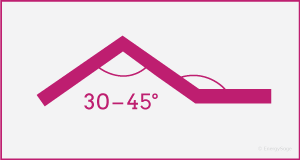In case the roof is very steep you may not be able to get the most optimal tilt angle for the panel especially if it is lower than the angle of the roof.
Roof slope for solar panels northeast.
Most roofs have an inclination of 30 to 40 degrees.
The energy reduces as we move away from this optimum angle.
5 things to know.
Panels mounted on a standard pitch roof facing east or west will produce approximately 15 less output than panels mounted on a south facing roof of a standard pitch.
This is important because it may affect the pitch of your solar panels.
At 20 15 away from the optimum angle the energy drops to 1 229kwh m2 day.
If you are trying to install solar panels on a steep roof it may not be possible to place panels at the optimal tilt with traditional racking systems.
The best alternative to panels on a non optimal roof are ground mount solar installations which can help overcome many of the limitations presented by roof mount solar.
In some cases your solar installer will install racks that allow the panels to be tilted slightly to maximize production.
There are many factors that affect the performance of your solar energy system including how sunny it is where you live which way your house faces and even the pitch of your roof.
At 30 the energy drops to 1 260kwh m2 year a reduction of just 0 4.
At this level the solar panel can lie flat on the roof and get enough sunlight to produce enough electricity.
Many roofs are going to have slopes between 30 and 40 degrees which means that solar panels can lie flush against the roof and produce enough electricity for attractive returns.
These systems are an excellent option for individuals who don t have good roofs for solar but have some open unshaded yard space to use.
Yes you can successfully have solar panels installed on the flat roof of your home or business.
Ideally a fixed roof mounted solar energy system should be at an angle that is equal to the latitude of the location where it is installed.
The pv system is looked at essentially like cladding and thus the wind load table for cladding is what is used to determine the load the panel system must resist depending on factors such as exposure windspeed roof area roof slope and where the panels are located on the roof such as near an edge or in the center.
If this applies to you consider increasing the tilt of your solar panels by 15 degrees during the winter.
Flat roofs have a minimal slope allowance that will accommodate solar pv panel systems.
So for this roof the optimum angle is 35 a bit over an 8 12 roof slope and at this angle the roof generates 1 265kwh m2 day.
Solar panels on a flat roof.
However pitch angles.
If you are able to adjust the tilt of your solar panels even manually they will be significantly more efficient.




























